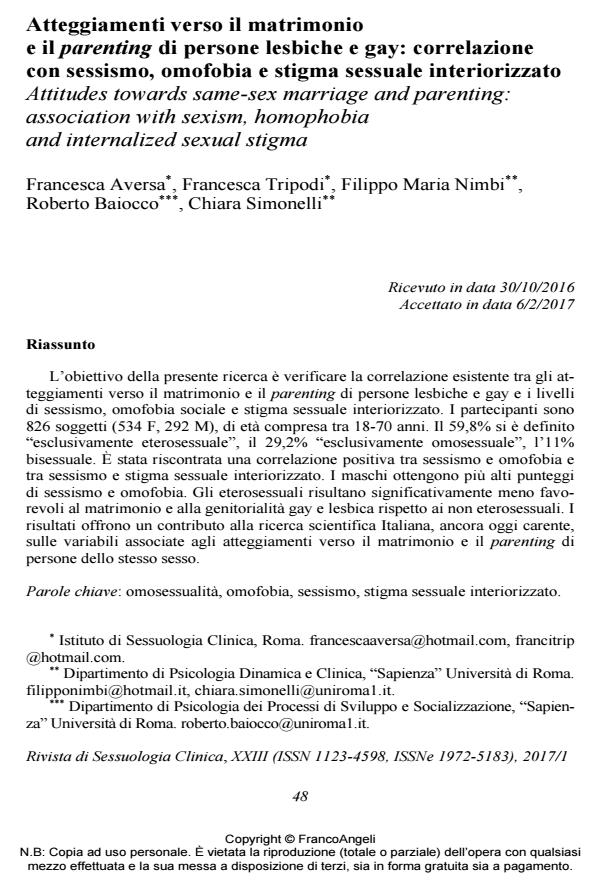Attitudes towards same-sex marriage and parenting: association with sexism, homophobia and internalized sexual stigma
Journal title RIVISTA DI SESSUOLOGIA CLINICA
Author/s Francesca Aversa, Francesca Tripodi, Filippo Maria Nimbi, Roberto Baiocco, Chiara Simonelli
Publishing Year 2017 Issue 2017/1
Language Italian Pages 21 P. 48-68 File size 436 KB
DOI 10.3280/RSC2017-001003
DOI is like a bar code for intellectual property: to have more infomation
click here
Below, you can see the article first page
If you want to buy this article in PDF format, you can do it, following the instructions to buy download credits

FrancoAngeli is member of Publishers International Linking Association, Inc (PILA), a not-for-profit association which run the CrossRef service enabling links to and from online scholarly content.
The objective of the present study is to explore the correlation between the atti-tudes towards marriage and parenting of lesbians and gays and levels of sexism, social homophobia and internalized sexual stigma. The participants were 826 (534 F, 292 M), aged between 18 and 70. The 59.8% defined him/her-self as "exclusive-ly heterosexual", 29.2% as "exclusively homosexual" and 11% as "bisexual". Positive correlations have been found between: sexism and homophobia, and sexism and internalized sexual stigma. Male subjects obtained higher scores in sex-ism and homophobia. Heterosexuals were significantly less favorable regarding gay and lesbian marriage and parenthood compared to the homosexuals. The re-sults offer a contribute to scientific research which still has significant gaps regarding the attitude-associated variables towards marriage and parenting between people of the same gender. Sexual education at schools and clinic supervision interventions should take these evidences into account.
Keywords: Homosexuality, homophobia, sexism, internalized sexual stigma.
- Attitudes of Italian Group Toward Homosexuality and Same-Sex Parenting L. Rollè, L. Chinaglia, L. Curti, A. Magliano, T. Trombetta, A.M. Caldarera, P. Brustia, E. Gerino, in Journal of Psychology and Psychotherapy Research /2018 pp.10
DOI: 10.12974/2313-1047.2018.05.2
Francesca Aversa, Francesca Tripodi, Filippo Maria Nimbi, Roberto Baiocco, Chiara Simonelli, Atteggiamenti verso il matrimonio e il parenting di persone lesbiche e gay: correlazione con sessismo, omofobia e stigma sessuale interiorizzato in "RIVISTA DI SESSUOLOGIA CLINICA" 1/2017, pp 48-68, DOI: 10.3280/RSC2017-001003